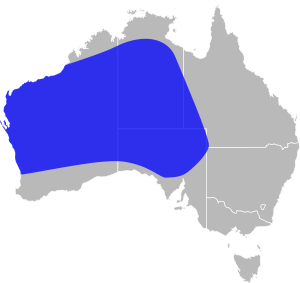Hooded scaly-foot facts for kids
Quick facts for kids Hooded scaly-foot |
|
|---|---|
| Conservation status | |
| Scientific classification | |
| Genus: |
Pygopus
|
| Species: |
nigriceps
|
 |
|
| Synonyms | |
|
Cryptodelma nigriceps Fischer, 1882 |
|
The hooded scaly-foot is a special kind of legless lizard that lives only in Australia. It's also known as the western scaly-foot or black-headed scaly-foot. This unique creature belongs to a family of lizards called Pygopodidae.
Contents
What Does a Hooded Scaly-foot Look Like?
Hooded scaly-foots are adult lizards that can grow to be about 45 to 55 centimeters (18 to 22 inches) long. Female scaly-foots are usually bigger than males. These lizards don't have any front legs at all. Their back legs are tiny, flat flaps covered in scales. These small flaps don't help them move around.
Scales and Colors
The scales on a hooded scaly-foot are smooth and have a slight shine. They have more than 120 large scales on their belly, which are much bigger than the scales on the rest of their body. Their body color can be brown or reddish-brown. Lizards living in the desert often look more orange, while others are a duller brown. Their underside is white. These lizards usually don't have many patterns on their bodies, but they might have faint dark lines that meet in the middle of their back.
The "Hood" and Eyes
A special feature of the hooded scaly-foot is the black bands on its head and neck, which can look like a hood. This "hood" includes a dark band across their eyes and lips, a dark smudge near their nostrils, and a wide band across their neck. As they get older, these dark bands might fade or blend together.
Their eyes are well-developed and don't have eyelids. Instead, they have a clear cover over their eyes, like a built-in goggle. They can clean this cover with their wide, fleshy tongue. They also have clear ear openings.
You can tell a hooded scaly-foot apart from other similar lizards because its nostril touches the first upper lip scale.
Where Do Hooded Scaly-foots Live?
The hooded scaly-foot can be found all over Australia. However, you won't find them in the wetter areas of the south or in Tasmania.
Daily Life and Habitat
These lizards are mostly active at night because the places they live are usually very hot during the day. But if the weather is cooler, they might look for food during the day. They live on the ground, but some have been seen climbing up to 1.5 meters (5 feet) high in plants. In zoos, hooded scaly-foots have lived for up to seven years. We don't know much about how long they live in the wild.
Hooded scaly-foots live in many different types of places, but they prefer dry, open areas. They especially like sandy deserts with spiky spinifex grass. They also live in open woodlands and shrublands. For shelter, they hide under rocks, woody debris, grass clumps, cracks in the soil, old animal burrows, insect holes, and even inside termite mounds.
What Do Hooded Scaly-foots Eat?
The hooded scaly-foot mainly eats small creatures that move around on the ground. Insects are their favorite food, but they also eat spider egg sacs and scorpions. They actively search for their prey. Once they catch a larger meal, they crush it and disable it by spinning their body quickly, like a crocodile. Then, they lick up the body fluids.
How Do Hooded Scaly-foots Move and Defend Themselves?
Scaly-foots move by wiggling their bodies and tails from side to side. In open areas, they have been seen moving in wiggly leaps. Their small hind-limb flaps stay close to their body when they move. However, they might stick them out if they are stressed or climbing.
Sounds and Mimicry
Hooded scaly-foots can make a sound. They let out a harsh squeak when they are stressed, and sometimes when they interact with other scaly-foots.
When they feel threatened, hooded scaly-foots will lift their heads and the front part of their bodies off the ground. They flatten their necks and flick their tongues. Sometimes, they even strike out. They do this to copy venomous snakes, which helps scare away predators. The markings on the hooded scaly-foot look a bit like those of young brown snakes.
Tail Shedding
If a hooded scaly-foot is caught, it will struggle fiercely, spin its body, and make long squeaking sounds. They can also easily drop their tails to escape. A new tail will grow back, and you can tell it's a new tail because the scales and pattern will look different.
Reproduction and Life Cycle
Hooded scaly-foots lay eggs. They usually lay two eggs at a time. These eggs have a soft, parchment-like shell. Other types of Pygopus lizards have been known to lay their eggs together in shared nests. The eggs usually hatch after about 66 to 77 days. Male hooded scaly-foots have special spine-like scales called pelvic spurs, in addition to their hind-limb flaps. These spurs are thought to help the male grip the female during mating.
Who Eats the Hooded Scaly-foot?
Many animals prey on the hooded scaly-foot. These include birds of prey (like eagles), venomous snakes, goannas (large Australian lizards), wild cats, and foxes. Another legless lizard, Burton's legless lizard (Lialis burtonis), is also known to eat other legless lizards. However, legless lizards are usually only a small part of these predators' diets.


